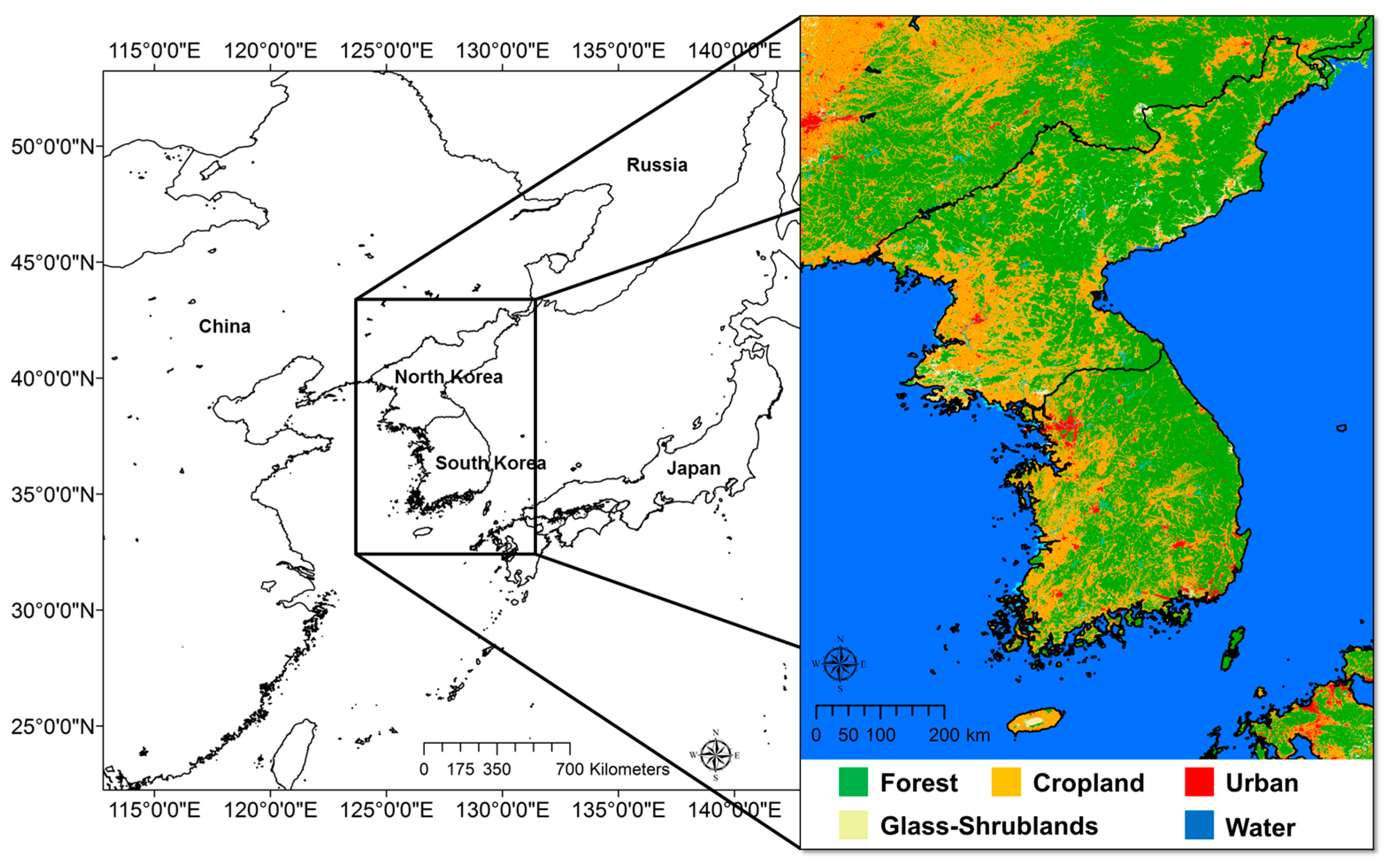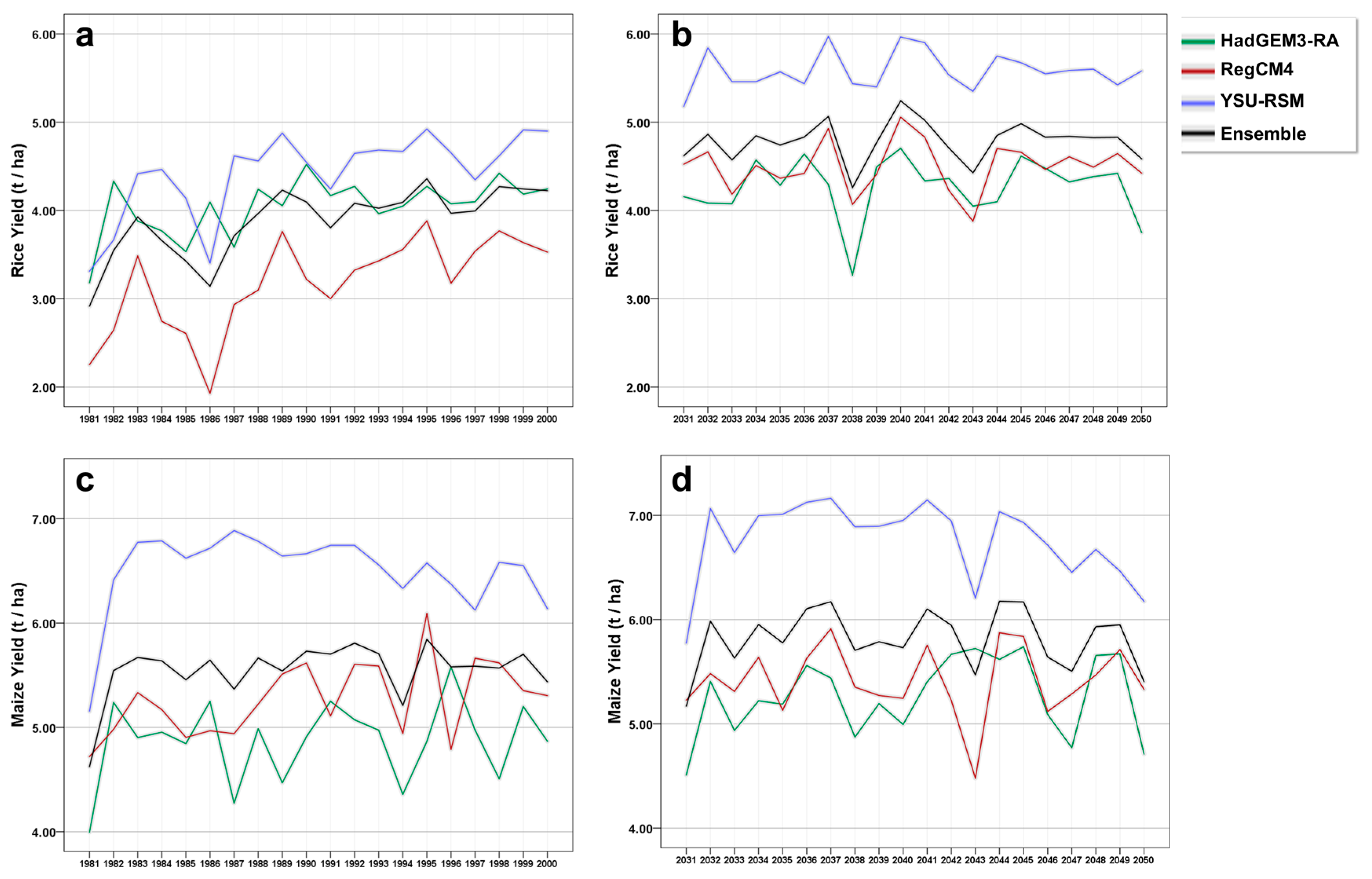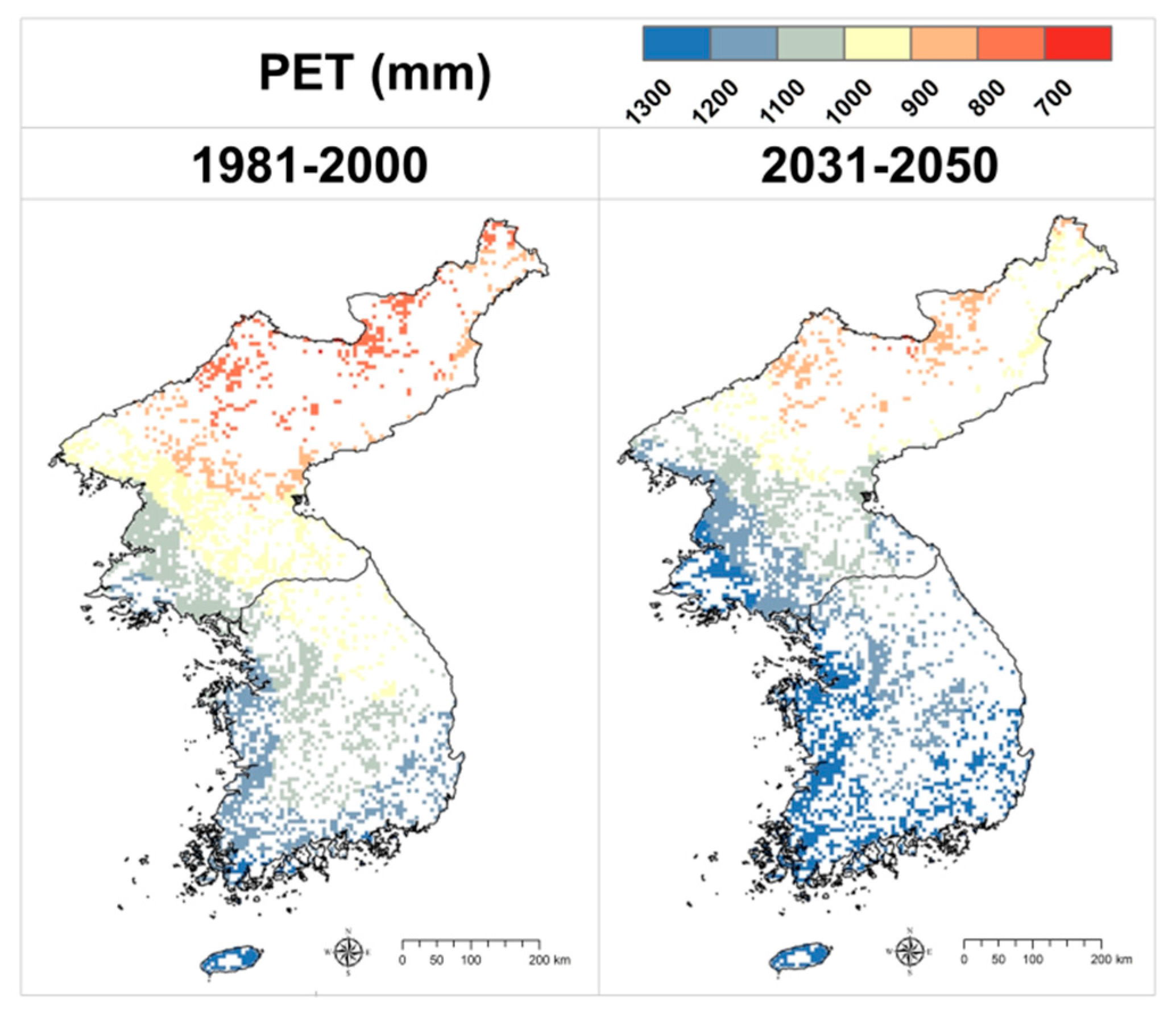Estimation of the Virtual Water Content of Main Crops on the Korean Peninsula Using Multiple Regional Climate Models and Evapotranspiration Methods
Abstract
:1. Introduction
2. Data and Methods
2.1. Research Area and Crops
2.2. Assessment Model Hierarchy
2.3. Multiple Regional Climate Models
2.4. EPIC Model and PET Methods
2.5. Method to Calculate Virtual Water Content of Crops
2.6. Other Data and Management Description
3. Results
3.1. Estimation of Crop Yield
3.1.1. Evaluation of the Model’s Performance
3.1.2. Estimation of Crop Yields Using Multiple RCMs
3.2. Estimation of PET Using Multiple Methods
3.3. Estimation of Consumptive Water Use by Growing Season Evapotranspiration
3.4. Virtual Water Content of Past and Future Using Multiple Data Sources
4. Discussion
4.1. Assessing the Ensemble Result of Crop Yield, PET, GET, and VWC
4.2. Implications for Agricultural Water Supply and Demand in the Korean Peninsula
5. Conclusions
Acknowledgments
Author contribution
Conflicts of interest
References
- Sachs, J.D. From millennium development goals to sustainable development goals. Lancet 2012, 379, 2206–2211. [Google Scholar] [CrossRef]
- IPCC. Climate Change 2014: Impacts, Adaptation, and Vulnerability. Part A: Global and Sectoral Aspects. Contribution of Working Group II to the Fifth Assessment Report of the Intergovernmental Panel on Climate Change; Cambridge University Press: Cambridge, UK, 2014. [Google Scholar]
- Griggs, D.; Stafford-Smith, M.; Gaffney, O.; Rockström, J.; Öhman, M.C.; Shyamsundar, P.; Noble, I. Policy: Sustainable development goals for people and planet. Nature 2013, 495, 305–307. [Google Scholar] [CrossRef] [PubMed]
- Wheeler, T.; Von Braun, J. Climate change impacts on global food security. Science 2013, 341, 508–513. [Google Scholar] [CrossRef] [PubMed]
- Godfray, H.C.J.; Garnett, T. Food security and sustainable intensification. Philos. Trans. R. Soc. B 2004, 369, 20120273. [Google Scholar] [CrossRef] [PubMed]
- Elliott, J.; Deryng, D.; Müller, C.; Frieler, K.; Konzmann, M.; Gerten, D.; Glotter, M.; Flörke, M.; Wada, Y.; Best, N.; et al. Constraints and potentials of future irrigation water availability on agricultural production under climate change. Proc. Natl. Acad. Sci. USA 2014, 111, 3239–3244. [Google Scholar] [CrossRef] [PubMed]
- Calzadilla, A.; Rehdanz, K.; Betts, R.; Falloon, P.; Wiltshire, A.; Tol, R.S. Climate change impacts on global agriculture. Clim. Chang. 2013, 120, 357–374. [Google Scholar] [CrossRef]
- Haddeland, I.; Heinke, J.; Biemans, H.; Eisner, S.; Flörke, M.; Hanasaki, N.; Stacke, T. Global water resources affected by human interventions and climate change. Proc. Natl. Acad. Sci. USA 2014, 111, 3251–3256. [Google Scholar] [CrossRef] [PubMed]
- Huang, B.; Polanski, S.; Cubasch, U. Assessment of precipitation climatology in an ensemble of CORDEX-East Asia regional climate simulations. Clim. Res. 2015, 64, 141–158. [Google Scholar] [CrossRef]
- Park, C.; Min, S.K.; Lee, D.; Cha, D.H.; Suh, M.S.; Kang, H.S.; Kwon, W.T. Evaluation of multiple regional climate models for summer climate extremes over East Asia. Clim. Dyn. 2016, 46, 2469–2486. [Google Scholar] [CrossRef]
- Hoekstra, A.Y.; Hung, P.Q. Globalisation of water resources: International virtual water flows in relation to crop trade. Glob. Environ. Chang. 2005, 15, 45–56. [Google Scholar] [CrossRef]
- Zhuo, L.; Mekonnen, M.M.; Hoekstra, A.Y. The effect of inter-annual variability of consumption, production, trade and climate on crop-related green and blue water footprints and inter-regional virtual water trade: A study for China (1978–2008). Water Res. 2016, 94, 73–85. [Google Scholar] [CrossRef] [PubMed]
- Liu, J.; Zehnder, A.J.; Yang, H. Global consumptive water use for crop production: The importance of green water and virtual water. Water Resour. Res. 2009, 45. [Google Scholar] [CrossRef]
- Liu, J.; Folberth, C.; Yang, H.; Röckström, J.; Abbaspour, K.; Zehnder, A.J. A global and spatially explicit assessment of climate change impacts on crop production and consumptive water use. PLoS ONE 2013, 8, e57750. [Google Scholar] [CrossRef] [PubMed]
- Zhao, Q.; Liu, J.; Khabarov, N.; Obersteiner, M.; Westphal, M. Impacts of climate change on virtual water content of crops in China. Ecol. Inform. 2014, 19, 26–34. [Google Scholar] [CrossRef]
- Zhuo, L.; Mekonnen, M.M.; Hoekstra, A.Y. Consumptive water footprint and virtual water trade scenarios for China—With a focus on crop production, consumption and trade. Environ. Int. 2016, 94, 211–223. [Google Scholar] [CrossRef] [PubMed]
- Chun, J.A.; Li, S.; Wang, Q.; Lee, W.S.; Lee, E.J.; Horstmann, N.; Park, H.; Veasna, T.; Vanndy, L.; Pros, K.; et al. Assessing rice productivity and adaptation strategies for Southeast Asia under climate change through multi-scale crop modeling. Agric. Syst. 2016, 143, 14–21. [Google Scholar] [CrossRef]
- Baek, H.-J.; Lee, J.; Lee, H.-S.; Hyun, Y.-K.; Cho, C.; Kwon, W.-T.; Marzin, C.; Gan, S.-Y.; Kim, M.-J.; Choi, D.-H. Climate change in the 21st century simulated by HadGEM2-AO under representative concentration pathways. Asia-Pac. J. Atmos. Sci. 2013, 49, 603–618. [Google Scholar] [CrossRef]
- Rosenzweig, C.; Elliott, J.; Deryng, D.; Ruane, A.C.; Müller, C.; Arneth, A.; Boote, K.J.; Folberth, C.; Glotter, M.; Khabarov, N. Assessing agricultural risks of climate change in the 21st century in a global gridded crop model intercomparison. Proc. Natl. Acad. Sci. USA 2014, 111, 3268–3273. [Google Scholar] [CrossRef] [PubMed]
- Wallach, D.; Rivington, M. A framework for assessing the uncertainty in crop model predictions. FACCE MACSUR Rep. 2014, 3, 1–5. [Google Scholar]
- Liu, W.; Yang, H.; Folberth, C.; Wang, X.; Luo, Q.; Schulin, R. Global investigation of impacts of PET methods on simulating crop-water relations for maize. Agric. For. Meteorol. 2016, 221, 164–175. [Google Scholar] [CrossRef]
- Choi, I.H.; Woo, J.C. Developmental process of forest policy direction in Korea and present status of forest desolation in North Korea. J. For. Sci. 2007, 23, 14. [Google Scholar]
- Jeon, Y.; Kim, Y. Land reform, income redistribution, and agricultural production in Korea. Econ. Dev. Cult. Chang. 2000, 48, 253–268. [Google Scholar] [CrossRef]
- Korea Rural Economic Institute (KREI). KREI Quarterly Agriculture Trends in North Korea; Korea Rural Economic Institute: Seoul, Korea, 2014. [Google Scholar]
- Lee, J.W.; Hong, S.Y.; Chang, E.C.; Suh, M.S.; Kang, H.S. Assessment of future climate change over east Asia due to the RCP scenarios downscaled by GRIMs-RMP. Clim. Dyn. 2014, 42, 733–747. [Google Scholar] [CrossRef]
- Giorgi, F.; Coppola, E.; Solmon, F.; Mariotti, L.; Sylla, M.B.; Bi, X.; Elguindi, N.; Diro, G.T.; Nari, V.; Giuliani, G.; et al. RegCM4: Model description and preliminary tests over multiple CORDEX domains. Clim. Res. 2012, 52, 7–29. [Google Scholar] [CrossRef]
- Williams, J.R.; Jones, C.A.; Dyke, P.T. A modeling approach to determining the relationship between erosion and soil productivity. Trans. ASABE 1984, 27, 129–144. [Google Scholar] [CrossRef]
- Williams, J.R.; Jones, C.A.; Kiniry, J.R.; Spanel, D.A. The EPIC crop growth model. Trans. ASAE 1989, 32, 497–511. [Google Scholar] [CrossRef]
- Knisel, W.G. GLEAMS: Groundwater Loading Effects of Agricultural Management Systems 2006; Version 2.10 (No. 5); University of Georgia: Athens, GA, USA, 2006. [Google Scholar]
- Izaurralde, R.; Williams, J.R.; McGill, W.B.; Rosenberg, N.J.; Jakas, M.Q. Simulating soil C dynamics with EPIC: Model description and testing against long-term data. Ecol. Model. 2006, 192, 362–384. [Google Scholar] [CrossRef]
- Renard, K.G.; Foster, G.R.; Weesies, G.A.; Porter, J.P. Rusle: Revised Universal Soil Loss Equation. J. Soil Water Conserv. 1991, 46, 30–33. [Google Scholar]
- Rinaldi, M. Application of EPIC model for irrigation scheduling of sunflower in Southern Italy. Agric. Water Manag. 2001, 49, 185–196. [Google Scholar] [CrossRef]
- Williams, J.R. The EPIC model. In Computer Models of Watershed Hydrology; Singh, V.P., Ed.; Water Resources Publications: Littleton, CO, USA, 1995. [Google Scholar]
- Xiong, W.; Balkovič, J.; van der Velde, M.; Zhang, X.; Izaurralde, R.C.; Skalský, R.; Lin, E.; Mueller, N.; Obersteiner, M. A calibration procedure to improve global rice yield simulations with EPIC. Ecol. Model. 2014, 273, 128–139. [Google Scholar] [CrossRef]
- Lim, C.H.; Lee, W.K.; Song, Y.; Eom, K.C. Assessing the EPIC model for estimation of future crops yield in South Korea. J. Clim. Chang. Res. 2015, 6, 21–31. [Google Scholar] [CrossRef]
- Lim, C.H.; Kim, M.; Lee, W.K.; Folberth, C. Spatially Explicit Assessment of Agricultural Water Equilibrium in the Korean Peninsula. Agric. Water Manag. 2017. under review. [Google Scholar]
- Balkovič, J.; van der Velde, M.; Schmid, E.; Skalský, R.; Khabarov, N.; Obersteiner, M.; Xiong, W. Pan-European crop modelling with EPIC: Implementation, up-scaling and regional crop yield validation. Agric. Syst. 2013, 120, 61–75. [Google Scholar] [CrossRef]
- Lim, C.H.; Choi, Y.; Kim, M.; Jeon, S.W.; Lee, W.K. Impact of deforestation on agro-environmental variables in cropland, North Korea. Sustainability 2017. under review. [Google Scholar]
- Yoo, B.H.; Kim, K.S. Development of a gridded climate data tool for the Coordinated Regional climate Downscaling Experiment data. Comput. Electron. Agric. 2017, 133, 128–140. [Google Scholar] [CrossRef]
- Nash, J.E.; Sutcliffe, J.V. River flow forecasting through conceptual models part I—A discussion of principles. J. Hydrol. 1970, 10, 282–290. [Google Scholar] [CrossRef]
- Niu, X.; Easterling, W.; Hays, C.J.; Jacobs, A.; Mearns, L. Reliability and input-data induced uncertainty of the EPIC model to estimate climate change impact on sorghum yields in the US Great Plains. Agric. Ecosyst. Environ. 2009, 129, 268–276. [Google Scholar] [CrossRef]
- Balkovič, J.; van der Velde, M.; Skalský, R.; Xiong, W.; Folberth, C.; Khabarov, N.; Smirnov, A.; Mueller, N.D.; Obersteiner, M. Global wheat production potentials and management flexibility under the representative concentration pathways. Glob. Planet. Chang. 2014, 122, 107–121. [Google Scholar] [CrossRef]
- Monteith, J. Evaporation and environment. Symp. Soc. Exp. Biol. 1965, 19, 205–234. [Google Scholar] [PubMed]
- Penman, H.L. Natural evaporation from open water, bare soil and grass. Proc. R. Soc. Lond. Ser. A 1948, 193, 120–145. [Google Scholar] [CrossRef]
- Priestley, C.; Taylor, R. On the assessment of surface heat flux and evaporation using large-scale parameters. Mon. Weather Rev. 1972, 100, 81–92. [Google Scholar] [CrossRef]
- Hargreaves, G.H.; Samani, Z.A. Reference crop evapotranspiration from temperature. Appl. Eng. Agric. 1985, 1, 96–99. [Google Scholar] [CrossRef]
- Baier, W.; Robertson, G.W. Estimation of latent evaporation from simple weather observations. Can. J. Plant Sci. 1965, 45, 276–284. [Google Scholar] [CrossRef]
- Liu, J.; Williams, J.R.; Zehnder, A.J.; Yang, H. GEPIC—Modelling wheat yield and crop water productivity with high resolution on a global scale. Agric. Syst. 2007, 94, 478–493. [Google Scholar] [CrossRef]
- Food Agriculture Organization. FAO Digital Soil Map of the World; FAO: Rome, Italy, 1995. [Google Scholar]
- Batjes, N.H. ISRIC-WISE Derived Soil Properties on a 5 by 5 Arc-Minutes Global Grid; ISRIC—World Soil Information: Wageningen, The Netherlands, 2006. [Google Scholar]
- Chen, J.; Chen, J.; Liao, A.; Cao, X.; Chen, L.; Chen, X.; Zhang, W. Global land cover mapping at 30 m resolution: A POK-based operational approach. ISPRS J. Photogramm. Remote Sens. 2015, 103, 7–27. [Google Scholar] [CrossRef]
- Kim, H.Y.; Ko, J.; Kang, S.; Tenhunen, J. Impacts of climate change on paddy rice yield in a temperate climate. Glob. Chang. Biol. 2013, 19, 548–562. [Google Scholar] [CrossRef] [PubMed]
- Shin, Y.; Lee, E.J.; Im, E.S.; Jung, I.W. Spatially distinct response of rice yield to autonomous adaptation under the CMIP5 multi-model projections. Asia-Pac. J. Atmos. Sci. 2017, 53, 21–30. [Google Scholar] [CrossRef]
- Liaqat, U.W.; Choi, M. Accuracy comparison of remotely sensed evapotranspiration products and their associated water stress footprints under different land cover types in Korean peninsula. J. Clean. Prod. 2017, 155, 93–104. [Google Scholar] [CrossRef]
- Chung, E.S.; Won, K.; Kim, Y.; Lee, H. Water resource vulnerability characteristics by district’s population size in a changing climate using subjective and objective weights. Sustainability 2014, 6, 6141–6157. [Google Scholar] [CrossRef]













| Method | Temperature (T, Tmin, Tmax) | Solar Radiation | Relative Humidity | Wind Speed | Reference |
|---|---|---|---|---|---|
| Penman–Monteith | ○ | ○ | ○ | ○ | Monteith (1965) |
| Penman | ○ | ○ | ○ | ○ | Penman (1948) |
| Priestley–Taylor | ○ | ○ | Priestley and Taylor (1972) | ||
| Hargreaves | ○ | Hargreaves and Samani (1985) | |||
| Baier–Robertson | ○ | Baier and Robertson (1965) |
| Year | Reported (t ha−1) | Estimated (t ha−1) | RMSE | E (NSEC) | RE (%) | ||
|---|---|---|---|---|---|---|---|
| Mean | SD | Mean | SD | ||||
| Rice Yield | |||||||
| 1981 | 4.03 | 0.39 | 3.96 | 0.36 | 0.28 | −0.41 | −1.12 |
| 1982 | 4.21 | 0.38 | 5.16 | 0.33 | 0.59 | −0.71 | 3.35 |
| 1983 | 4.20 | 0.39 | 5.12 | 0.37 | 0.51 | −1.01 | 4.28 |
| 1984 | 4.38 | 0.40 | 4.77 | 0.54 | 0.40 | −0.01 | 1.79 |
| 1985 | 4.31 | 0.42 | 4.81 | 0.45 | 0.57 | −0.65 | 5.21 |
| 1986 | 4.25 | 0.68 | 4.85 | 0.43 | 0.63 | −0.72 | 2.56 |
| 1987 | 4.19 | 0.42 | 4.08 | 0.27 | 0.31 | −0.08 | −1.93 |
| 1988 | 4.64 | 0.45 | 4.98 | 0.31 | 0.44 | −0.48 | 1.52 |
| 1989 | 4.56 | 0.34 | 4.67 | 0.41 | 0.32 | −0.09 | 0.69 |
| 1990 | 4.34 | 0.42 | 4.87 | 0.56 | 0.56 | −1.08 | 2.87 |
| 1991 | 4.28 | 0.34 | 4.69 | 0.27 | 0.48 | −0.57 | 1.36 |
| 1992 | 4.44 | 0.34 | 5.44 | 0.63 | 0.87 | −0.82 | 3.82 |
| 1993 | 4.08 | 0.58 | 4.84 | 0.33 | 0.74 | −1.16 | 2.61 |
| 1994 | 4.45 | 0.32 | 4.56 | 0.45 | 0.27 | −0.25 | 0.42 |
| 1995 | 4.35 | 0.28 | 4.90 | 0.29 | 0.59 | −0.89 | 1.93 |
| 1996 | 4.94 | 0.26 | 4.56 | 0.36 | 0.41 | −0.12 | −1.25 |
| 1997 | 5.00 | 0.32 | 4.89 | 0.42 | 0.37 | −0.08 | −0.73 |
| 1998 | 4.62 | 0.36 | 5.01 | 0.43 | 0.45 | −0.33 | 1.13 |
| 1999 | 4.78 | 0.37 | 3.91 | 0.27 | 0.77 | −1.02 | −3.27 |
| 2000 | 4.80 | 0.31 | 4.99 | 0.44 | 0.29 | −0.04 | 1.11 |
| Maize Yield | |||||||
| 1981 | 4.38 | 1.58 | 4.32 | 0.18 | 0.42 | −0.51 | −0.81 |
| 1982 | 4.12 | 1.37 | 5.20 | 0.38 | 0.87 | −1.12 | 3.67 |
| 1983 | 3.66 | 1.24 | 5.36 | 0.28 | 1.21 | −2.33 | 6.15 |
| 1984 | 4.44 | 1.61 | 5.05 | 0.33 | 0.75 | −0.62 | 2.49 |
| 1985 | 5.04 | 1.76 | 5.26 | 0.33 | 0.38 | −0.09 | 1.22 |
| 1986 | 4.79 | 1.71 | 5.47 | 0.43 | 0.73 | −0.43 | 5.76 |
| 1987 | 4.85 | 1.63 | 4.60 | 0.29 | 0.42 | −0.11 | −1.93 |
| 1988 | 4.80 | 1.93 | 5.25 | 0.25 | 0.55 | −0.91 | 7.32 |
| 1989 | 4.88 | 1.84 | 4.38 | 0.22 | 0.65 | −1.15 | −1.86 |
| 1990 | 4.61 | 1.78 | 5.07 | 0.29 | 0.71 | −1.32 | 2.83 |
| 1991 | 3.41 | 1.34 | 5.57 | 0.37 | 1.63 | −2.78 | 12.32 |
| 1992 | 4.40 | 1.52 | 5.63 | 0.38 | 0.88 | −1.18 | 8.17 |
| 1993 | 4.18 | 1.54 | 5.15 | 0.29 | 0.91 | −1.36 | 5.86 |
| 1994 | 4.09 | 1.53 | 4.39 | 0.27 | 0.37 | −0.12 | 1.04 |
| 1995 | 4.25 | 1.54 | 5.19 | 0.35 | 0.82 | −0.58 | 3.63 |
| 1996 | 4.03 | 1.60 | 5.83 | 0.29 | 1.44 | −2.30 | 8.29 |
| 1997 | 4.11 | 1.48 | 5.19 | 0.27 | 1.01 | −0.91 | 5.59 |
| 1998 | 3.98 | 1.31 | 4.68 | 0.30 | 0.71 | −1.21 | 5.15 |
| 1999 | 3.94 | 1.37 | 5.30 | 0.30 | 1.09 | −0.81 | 10.28 |
| 2000 | 4.06 | 1.16 | 5.06 | 0.24 | 0.91 | −1.11 | 9.11 |
© 2017 by the authors. Licensee MDPI, Basel, Switzerland. This article is an open access article distributed under the terms and conditions of the Creative Commons Attribution (CC BY) license (http://creativecommons.org/licenses/by/4.0/).
Share and Cite
Lim, C.-H.; Kim, S.H.; Choi, Y.; Kafatos, M.C.; Lee, W.-K. Estimation of the Virtual Water Content of Main Crops on the Korean Peninsula Using Multiple Regional Climate Models and Evapotranspiration Methods. Sustainability 2017, 9, 1172. https://doi.org/10.3390/su9071172
Lim C-H, Kim SH, Choi Y, Kafatos MC, Lee W-K. Estimation of the Virtual Water Content of Main Crops on the Korean Peninsula Using Multiple Regional Climate Models and Evapotranspiration Methods. Sustainability. 2017; 9(7):1172. https://doi.org/10.3390/su9071172
Chicago/Turabian StyleLim, Chul-Hee, Seung Hee Kim, Yuyoung Choi, Menas C. Kafatos, and Woo-Kyun Lee. 2017. "Estimation of the Virtual Water Content of Main Crops on the Korean Peninsula Using Multiple Regional Climate Models and Evapotranspiration Methods" Sustainability 9, no. 7: 1172. https://doi.org/10.3390/su9071172






